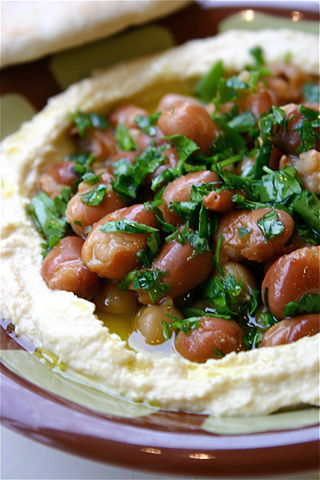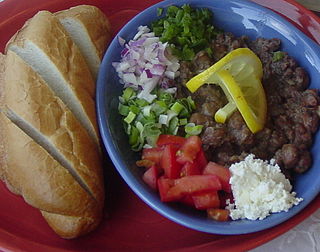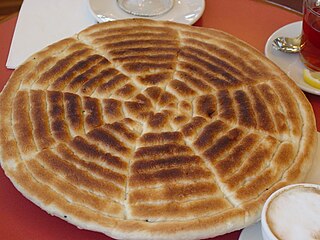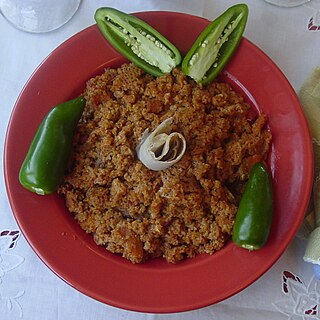Related Research Articles

Ethiopian cuisine characteristically consists of vegetable and often very spicy meat dishes. This is usually in the form of wat, a thick stew, served on top of injera, a large sourdough flatbread, which is about 50 centimeters in diameter and made out of fermented teff flour. Ethiopians eat most of the time with their right hands, using pieces of injera to pick up bites of entrées and side dishes.

Porridge is a food made by heating or boiling ground, crushed or chopped starchy plants, typically grain, in milk or water. It is often cooked or served with added flavourings such as sugar, honey, (dried) fruit or syrup to make a sweet cereal, or it can be mixed with spices, meat or vegetables to make a savoury dish. It is usually served hot in a bowl, depending on its consistency. Oat porridge, or oatmeal, is one of the most common types of porridge. Gruel is a thinner version of porridge.

Cornmeal is a meal or a cell membrane ground from dried corn. It is a common staple food, and is ground to coarse, medium, and fine consistencies, but not as fine as wheat flour can be. In Mexico, very finely ground cornmeal is referred to as corn flour. When fine cornmeal is made from maize that has been soaked in an alkaline solution, e.g., limewater, it is called masa harina, which is used for making arepas, tamales and tortillas. Boiled cornmeal is called polenta in Italy and is also a traditional dish and bread substitute in Romania.

Goulash is a soup or stew of meat and vegetables seasoned with paprika and other spices. Originating in Hungary, goulash is a common meal predominantly eaten in Central Europe but also in other parts of Europe. It is one of the national dishes of Hungary and a symbol of the country.

Eritrean cuisine is based on Eritrea's native culinary traditions, but also arises from social interchanges with other regions. The local cuisine shares similarities with the cuisine of neighboring Ethiopia and the cuisines from other African countries in the region.

Bunny chow, often referred to simply as a bunny, is an Indian South African fast food dish consisting of a hollowed-out loaf of white bread filled with curry and a serving of salad on the side. It originated among Indian South Africans of Durban. Throughout various South African communities one can find cultural adaptations to the original version of the bunny chow, which uses only a quarter loaf of bread and depending on which part of the country you are in, is sometimes called a skhambane,kota ("quarter") or shibobo; it is a name that it shares with sphatlho, a South African dish that evolved from the bunny chow.

Ful medames, or simply fūl, is a stew of cooked fava beans served with olive oil, cumin, and optionally with chopped parsley, garlic, onion, lemon juice, chili pepper, and other vegetable, herb, and spice ingredients. Ful medames is traditionally made in and served out of a large metal jug. It is notably a staple food in Egypt and is considered a national dish, especially in the northern cities of Cairo and Gizah. Fava beans can sometimes be also found in other cuisines in the Middle East, and Africa, though cooked differently.

A teacake in England is generally a light yeast-based sweet bun containing dried fruit, typically served toasted and buttered. In the U.S. teacakes can be cookies or small cakes. In Sweden, they are soft, round, flat wheat breads made with milk and a little sugar, and used to make buttered ham or cheese sandwiches. In India and Australia, a teacake is more like a butter cake. Tea refers to the popular beverage to which these baked goods are an accompaniment.

Ugandan cuisine consists of traditional and modern cooking styles, practices, foods and dishes in Uganda, with English, Arab, and Asian influences.

A sausage sandwich is a sandwich containing cooked sausage. It may consist of an oblong bread roll such as a baguette or ciabatta roll, and sliced or whole links of sausage, such as hot or sweet Italian sausage, Polish sausage, German sausage, Mediterranean merguez, andouille or chorizo. Popular toppings include mustard, brown sauce, ketchup, BBQ sauce, steak sauce, peppers, onions, sauerkraut, chili, and salsa.

Somali cuisine is the traditional cuisine of Somalis from the Horn of Africa. Somali cuisine does have moderate foreign influence from different countries mainly due to trade but traditionally also varies from region to region due to the expansive landmass Somalis inhabit with traditions varying in different regions which makes it a fusion of differing Somali culinary traditions. It is the product of Somalia's tradition of trade and commerce. Some notable Somali delicacies include Kimis/Sabaayad, Canjeero/Lahoh, Xalwo (Halwa), Sambuusa (Samosa), Bariis Iskukaris, and Muqmad/Odkac.

Shahan ful, simplified to ful, is a dish common in Sudan, South Sudan, Somalia, Ethiopia and other parts of the Horn of Africa, which is generally served for breakfast. Believed to originate from Sudan, it is made by slowly cooking fava beans in water. Once the beans have softened, they are crushed into a coarse paste. It is often served with chopped green onions, tomatoes, and hot green peppers, as well as yogurt, feta cheese, olive oil, tesmi, berbere, lemon juice, cumin, and chili pepper. It is typically eaten without the aid of utensils accompanied with a bread roll. It is popular during the Ramadan season and during the various Lents.

Himbasha or Ambasha, is an Tigrayan celebration bread that is slightly sweet. It became popular in Ethiopian cuisine and Eritrean cuisine, often served at special occasions. It is prepared in a number of varieties depending on region and nationality with the main two being the quintessential Ethiopian variant, and the more distinctive Eritrean flavoring with raisins.

Fit-fit or fir-fir, , is an Eritrean and Ethiopian food typically served as breakfast. Fit-fit is served by preparing sauce and shredding injera or kitcha into pieces and mixing the two. It is generally made with shredded flat bread, spiced clarified butter, and the hot spice berbere. There are two main varieties of fit-fit depending on the type of flatbread being used: the sourdough injera and the unleavened kitcha.

Pinchitos or Pinchos Morunos is a Moorish-derived food in Spanish cuisine, similar to kebab. The name pinchitos is used in the southern Spanish autonomous communities of Andalusia and Extremadura. They consist of small cubes of meat threaded onto a skewer which are traditionally cooked over charcoal braziers.

Sudanese cuisine is greatly affected by the historical cross-cultural influences of Arab, Nubian, Egyptian, Turkish, and Levantine cuisine in Sudan. Many Sudanese foods have been around for thousands of years. The most common meats eaten are lamb and chicken, in accordance with the Muslim halal laws. Most meals are communal and often shared with family, neighbors, and guests, as part of Sudanese hospitality.

Djiboutian cuisine is a mixture of Somali, Afar, Yemeni, and French cuisine, with some additional South Asian culinary influences.
References
https://www.greatbritishchefs.com/features/east-african-food-guide